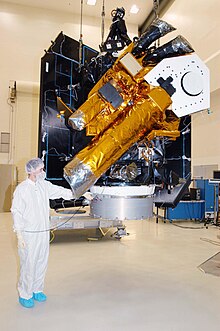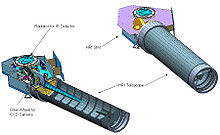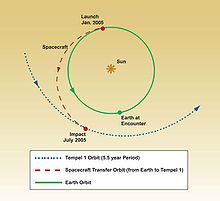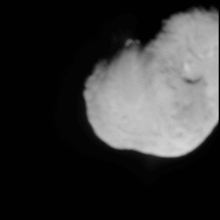Deep Impact (probe)
| Deep impact | ||||||||||||||||||||||||||||
|---|---|---|---|---|---|---|---|---|---|---|---|---|---|---|---|---|---|---|---|---|---|---|---|---|---|---|---|---|
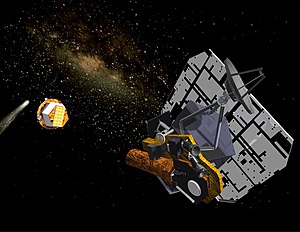 Deep impact on the approach to Temple 1, shortly after the impactor ejected (computer graphics) |
||||||||||||||||||||||||||||
| NSSDC ID | 2005-001A (probe) 2005-001 # (impactor) |
|||||||||||||||||||||||||||
| Mission goal | Temple 1 | |||||||||||||||||||||||||||
| Client |
|
|||||||||||||||||||||||||||
| Launcher | Delta II 7925 | |||||||||||||||||||||||||||
| construction | ||||||||||||||||||||||||||||
| Takeoff mass | about 1020 kg (of which 372 kg from the impactor) | |||||||||||||||||||||||||||
| Instruments | ||||||||||||||||||||||||||||
|
HRI, MRI, ITS |
||||||||||||||||||||||||||||
| Course of the mission | ||||||||||||||||||||||||||||
| Start date | January 12, 2005, 18:47 UTC | |||||||||||||||||||||||||||
| launch pad | Cape Canaveral , LC-17B | |||||||||||||||||||||||||||
| End date | August 8, 2013 | |||||||||||||||||||||||||||
|
||||||||||||||||||||||||||||
Deep Impact ( English for 'deep impact', but also 'strong impression') was a NASA mission of the Discovery Program to comet Temple 1 , which orbits the sun with a period of five and a half years and extends the earth up to 133 million kilometers approaching. The space probe shared its name with the 1998 disaster film Deep Impact , which is about a comet that threatens to collide with the earth. However, the name identity is said to have arisen by chance.
The mission was a collaborative effort between the University of Maryland , JPL, and Ball Aerospace . NASA invested six years of work and a total of $ 333 million in the mission, including $ 267 million for the probe itself, $ 15 million for the primary mission (through August 3, 2005) and about $ 50 million for the launcher.
After the completion of the primary mission, the mission of the flyby probe was extended. Under the mission name EPOXI , the probe pursued new targets until the last contact on August 8, 2013. During a flyby on November 4, 2010, pictures of comet 103P / Hartley were taken from a distance of only 700 kilometers in order to explore it more closely. The HRI telescope was also used to search for Earth-like exoplanets .
Mission objectives
The main mission goal of Deep Impact was the exploration of the interior of the comet Temple 1. For this purpose a 372 kg projectile (impactor) was brought into the trajectory of the comet, which hit there and left a crater. The impact and the ejected material were examined with the instruments of the probe and with further earth- and space-based telescopes. For the first time it was possible to reveal the inside of a comet and to release the original material of the solar system from inside the comet. This material dates from the time the solar system was formed and forms the nuclei of comets. Scientists hope that this new perspective will not only give them a better understanding of comets, but also better understand the role of comets in the early history of the solar system. The mission objectives in detail were:
- Improvement of the understanding of the key properties of a comet's nucleus and, for the first time, direct exploration of the comet's interior
- Determination of properties of the surface layers such as density , porosity , stability and composition
- Comparison of the surface and inner layers of the comet by observing the crater and the original surface before the impact
- Improving the understanding of the evolution of a cometary nucleus, especially the transition to the state of rest, by comparing the interior and the surface
The aim of the mission was thus to explore the differences between the properties of the interior of a comet's nucleus and those of its surface.
technology
Deep Impact consisted of two components: the flyby probe and the impactor, which hit the comet on July 4, 2005 and was destroyed in the process. The flyby probe served the impactor as a bus until shortly before the impact . The total mass of the two components at the start was 973 kg (according to other information 1020 kg).
Flyby probe
The flyby probe for the Deep Impact mission was developed by Ball Aerospace. It is about 3.2 m long, 1.7 m wide and 2.3 m high and had a mass of 601 kg (according to other information 650 kg) at take-off, of which 86 kg came from the fuel. The probe is three-axis stabilized and has a fixed, 2.8 m × 2.8 m solar panel, which can deliver up to 750 watts of power depending on the distance to the sun. A NiH is used for energy storage 2 - accumulator with a capacity of 16 ampere hours. The structure of the probe consists of aluminum profiles and aluminum in a sandwich honeycomb construction .
The flyby probe has two redundant computer systems. The heart of the onboard computer is faster, a 133 MHz, from 10.4 million transistors existing 32-bit rad750 - processor . The processor is basically a radiation- hardened PowerPC-750 G3 and the successor to the RAD6000 processor, which was used in the Mars rovers Spirit and Opportunity , for example . The deployment in Deep Impact was the first deployment of a RAD750 processor. Both computers in the probe have a shared memory of 1024 Mbytes. 309 Mbytes of scientific data were expected from the spacecraft during the primary mission.
Communication with the earth takes place in the X-band on an 8 GHz frequency with a maximum of 175 kbit / s to earth and 125 bit / s to the probe. The Impaktor communicated in the S-band at 64 kbit / s over a maximum distance of 8700 km. The probe has a moveable 1 m high gain antenna (HGA) and two fixed low gain antennas (LGA). A propulsion system consisting of a group of engines is available for course corrections. It burns with a total thrust of 5000 N hydrazine and is able to produce a total speed change ( Delta v ) of 190 m / s.
Impactor
The impactor also comes from Ball Aerospace and was 1 m high, 1 m in diameter and weighed 372 kg, 8 kg of which was used for course corrections immediately before impact. The impactor consisted mainly of copper (49%) and aluminum (24%). This mixture reduced contamination of the spectral lines of the comet's nucleus, which were recorded after impact, since occurrences of copper on the comet were not expected. 113 kg of the total impactor mass were " cratering mass ", intended to create the largest possible crater. This mass consisted of several copper plates that were attached to the front end of the impactor. These plates formed a spherical shape.
The impactor was disconnected from the flyby probe, to which it was mechanically and electrically connected, 24 hours before it hit the comet. Only for the last 24 hours did it draw its energy from an on-board non-rechargeable battery with a capacity of 250 ampere-hours. The impactor's on-board computer and flight controls were similar to the flyby probe. Due to its short service life, the impactor, unlike the flyby probe, did not have any redundant systems. The transmission data rate to the flyby probe was 64 kbit / s over a maximum distance of 8700 km. Commands were transmitted to the impactor at 16 kbit / s. The hydrazine-powered propulsion system consisted of a group of engines with a total thrust of 1750 N and allowed a speed change of 25 m / s.
The Impaktor carried a CD that was described by 625,000 names of Internet users who registered for the “ Send Your Name to a Comet ” campaign on the Deep Impact website between May 2003 and the end of January 2004 .
Instruments
For cost reasons, the mission's experiments had to be limited to just three instruments, two of which (HRI and MRI) on the flyby stage and one (ITS) on the impactor. The instruments of the flyby probe weigh a total of 90 kg, an electrical output of 92 watts is required for operation. The main task is to record infrared spectra and photos in visible light, which are then to be transmitted to earth. All three instruments were developed by Ball Aerospace.
- High-Resolution Instrument (HRI), "high-resolution instrument"
- HRI is the main instrument on the flyby probe and is one of the largest instruments ever used on a spacecraft. It consists of a Cassegrain telescope with a diameter of 30 cm and a focal length of 10.5 m and the Spectral Imaging Module (SIM), which contains the measurement electronics. The telescope directs the incoming light - divided by a dichroic beam splitter - simultaneously to a multispectral - CCD camera and an infrared spectrometer . The multispectral camera receives the visible light in the range from 0.3 to 1 µm, the spectrometer near-infrared light from 1 to 5 µm.
- The camera has a frame transfer CCD with 1008 × 1008 active image points (pixels) and a viewing angle of 0.118 °. From a distance of 700 km, a resolution of around 1.4 m per pixel should be achieved. For multi-spectral recordings, the camera is equipped with a filter wheel that contains seven filters and two clear apertures . Five of the filters are centered on the wavelengths of 450, 550, 650, 750 and 850 nm. Two further filters are bandpass filters for 340 to 400 nm and for 900 to 960 nm. The readout time of the CCD is 1.8 s. In order to reduce the readout time for recordings in quick succession (e.g. when approaching the cometary nucleus), the CCD can be operated in a sub-frame mode, whereby only 128 × 128 pixels are used.
- The spectrometer uses a two- prism design and has a 1024 × 1024 HgCdTe detector. Only half of the detector is active, so that only 1024 × 512 pixels are effectively available. In spectrometer mode, HRI has a focal length of 3.6 m. The infrared spectrometer delivers spectral images in 1–4.8 µm wavelength, the spatial resolution is 10 m from a distance of approx. 700 km. The spectral resolution λ / Δλ is strongly dependent on the wavelength: it varies from 740 at 1.0 µm to a minimum of 210 at 2.5 µm and is again at 385 at 4.8 µm.
- Development of the instrument began in 2001, it also incorporates some of the technologies from the Wide Field Camera 3 , which the Hubble Space Telescope was to be equipped with in 2008. When the first test images were taken with the HRI after the start of the probe, it quickly became clear that the camera was not achieving the intended resolution. A manufacturing error in the focusing of the telescope was found to be the cause. However, the NASA engineers were confident that they would be able to retrospectively calculate the focusing error using algorithms that had already been developed for the Hubble space telescope and thus still achieve the camera's nominal resolution . The pictures published after the meeting with the comet nevertheless showed certain blurring, so that it can be assumed that the focusing error could not be completely eliminated.
- Medium-Resolution Instrument (MRI), "medium-resolution instrument"
- MRI is the second instrument of the flyby probe. It is a smaller Cassegrain telescope with a diameter of 12 cm and a focal length of 2.1 m. MRI is equipped with a filter wheel which contains eight filters and two clear apertures. Some of the filters are identical to the filters on the HRI camera, others are designed to isolate C 2 and carbon-nitrogen (CN) compounds. MRI has a frame transfer CCD with 1024 × 1024 pixels and a viewing angle of 0.587 °. The read-out time of the CCD is 1.8 s. Here, too, it is possible to use parts of the CCD for faster recordings ( sub-frame mode). Due to its larger field of view, MRI was used to observe the released crater material and the crater itself; it was also used for star navigation during the last ten days when approaching the comet . From a distance of 700 km, the MRI was able to image the entire comet with a resolution of 10 m per pixel.
- Impactor Targeting Sensor (ITS), "Impactor target sensor"
- ITS was the only instrument on the impactor and was a copy of the flyby probe MRI. The only difference was that ITS did not have a multispectral filter wheel. The 12 cm telescope provided images for navigation as well as close-ups of the impact site shortly before the impact. The best resolution should be achieved with 20 cm per pixel from a height of 20 km. It is assumed that dust particle impacts disrupted the optics of the ITS by a kind of "sandblasting effect", since the last image of the impact point was taken with a resolution of less than 3 m / pixel instead of the expected 1.2 m / pixel. ITS provided the last image 3.7 seconds before the impact, but more than one field of view from the point of impact.
Course of the mission
The first proposals for a comet impact mission came from NASA back in 1996. But at that time NASA engineers remained skeptical as to whether the comet could be hit. A revised and technologically up-to-date mission proposal, called Deep Impact, was selected by NASA in March 1998 for a mission within the framework of the Discovery program, and in November 1998 Deep Impact was one of the five finalists with the best scientific Yield of a total of 26 proposals. Finally, on July 7, 1999, Deep Impact, under the direction of Michael A'Hearn of the University of Maryland at College Park , was approved along with MESSENGER for funding under the Discovery program. The cost of the spacecraft was then given at 240 million US dollars. Both parts of the deep impact spacecraft (flyby probe and impactor) and the three scientific instruments were manufactured at Ball Aerospace in Boulder (Colorado) , USA.
begin
During the development of the deep-impact mission, the start of the probe was initially planned for January 2004 with a swing-by maneuver on Earth on December 31, 2004 and the encounter with comet Tempel 1 on July 4, 2005. However, due to difficulties in the development of the probe, the start date could not be kept, which was finally postponed to December 30, 2004. As a result, the probe flew on a direct route to the comet, but needed a somewhat more powerful and therefore more expensive launcher.
On October 18, 2004, Deep Impact arrived at the Kennedy Space Center to prepare for launch. However, the start date on December 30, 2004 could not be kept and was initially postponed to January 8, 2005 in order to have more time for software tests. Deep Impact was finally launched on January 12, 2005 at 18: 47: 08.574 UTC with a Delta-II -7925 launcher equipped with a Star-48 upper stage from Launch Pad 17B of Cape Canaveral Air Force Station for a six-month and Traveled 431 million kilometers to Comet Temple 1. Shortly after being shot into the interplanetary transfer orbit, the probe went into safe mode , but could be reactivated quickly. An overly sensitive temperature sensor was found to be the cause, which should not endanger the mission any further.
flight
After the successful launch, the mission's commissioning phase began , during which the flight systems and instruments were activated, tested and calibrated . These tests showed that the resolution of the HRI telescope was reduced; it later turned out that this error can be partially corrected afterwards by editing it on earth (more on this in the HRI section of this article).
On February 11, 2005, the first course correction maneuver was carried out as planned. This maneuver was so precise that the next planned course correction on March 31st could be canceled. The cruise phase began on March 25 and was supposed to run until 60 days before the comet's arrival. On April 25, Deep Impact took the first photo of the target comet with the MRI instrument, which at the time was still 63.9 million kilometers away from the probe. The second course correction maneuver followed on May 4, with the engines firing for 95 seconds and changing the speed of the probe by 18.2 km / h (5 m / s).
The approach phase began on May 5 and ran from the 60th to the fifth day before the comet hit. 60 days prior to arrival should be the earliest possible appointment to be able to discover the comet with the MRI instrument. In fact, as mentioned above, the comet was successfully photographed on April 25th. During this phase of flight the comet's orbit, its rotation, activity and dust properties were studied. On June 14 and 22, Deep Impact observed two eruptions on the comet, the last six times stronger than the first.
The more precise alignment of the probe with its target began three weeks before the impact. For this purpose, continuous recordings of the comet were made in order to determine the exact parameters for the last two course corrections ( targeting maneuver ) before the impactor was cut off. The first targeting maneuver was carried out on June 23 , whereby the speed was changed by 6 m / s and the probe was steered into a target window 100 km wide.
Encounter with the comet
The following times relate to the so-called Earth-receive - UTC time, which means that the actual event actually occurred about 7 min 26 s earlier. This is the time it takes for a radio signal moving at the speed of light to travel from the spacecraft to Earth.
The encounter phase started five days before and ended one day after the impact. On July 2nd, six hours before the impactor was cut off, the second and final targeting maneuver was carried out. The engines fired for 30 seconds and changed the speed of the probe by about 1 km / h (about 0.278 m / s). She was now steered into a target window about 15 km wide. On July 3rd at 6:07 am, approximately 24 hours before the impact, the impactor was separated by detached springs at a speed of 34.8 cm / s. Previously it was switched to on-board power supply at 5:12 am. At 6:19, twelve minutes after the impactor was disconnected, the engines of the flyby probe fired for 14 minutes and reduced their speed by 102 m / s in order to divert the probe from the collision course and gain distance from the impactor. 22 hours before the impact, the impactor took its first image of the comet's nucleus.
At 3:53 a.m. on July 4, two hours before the impact, the car navigation software took over control of the impactor. The car navigation system took a picture of the comet every 15 seconds to determine the brightest point on the surface. At this point, the impactor should be controlled with the help of three Impactor Targeting Maneuvers (ITMs) . This was intended to cause the projectile to descend in a well-visible area, illuminated by the sun, in order to be able to observe the event from the flyby probe under optimal conditions. The first ITM occurred at 4:22 and lasted 20 seconds, the second at 5:17, using 0.36 kg of fuel, and the third and final at 5:39 for 44 seconds with 0.37 kg of fuel used.
The impact occurred at 5:52 am. The last image was transferred from the impactor to the mother probe 3.7 seconds before the collision from a height of about 30 km above the surface. The impactor hit at an angle of about 25 degrees. The spacecraft and comet moved in independent orbits around the sun, the probe at 21.9 km / s and the comet at 29.9 km / s. The collision took place at a relative speed of 10.3 km / s (37,080 km / h), with about 19 gigajoules or 4.5 tons of TNT equivalent energy being released. The impact reduced the comet's speed by only 0.0001 mm / s, which is almost immeasurable.
At the time of the impact, the flyby probe was approximately 8,600 km from the point of impact. The instruments of the flyby probe observed the impact site before and 13 minutes afterwards. At 6:05 am, the probe was aligned so that the solar panel protected it from the particle impacts as it passed the cometary coma . During this time, the instruments could not see the comet. At 6:51 am, the probe finally turned its instruments back towards the comet in order to carry out observations of the escaping material for a further 24 hours.
The event was also observed by several telescopes stationed in space and on Earth. The space observatories involved included the Hubble Space Telescope, Spitzer , Chandra , GALEX , SWAS and Swift . The European Space Agency (ESA) aimed the instruments of the Rosetta space probe at the impact of the impactor from a distance of about 80 million kilometers across the illumination from the sun.
Results
The size of the comet could be determined by the space probe's recordings at 7.6 × 4.9 km and its albedo at 0.04.
Shortly after the impact of the impactor, a thermal flash was observed, in which the projectile was explosively destroyed. As a result of the explosion , a fountain of around 3,500 ° C hot, molten core material with a total mass of around four tons and a speed of 5 to 8 km / s rose. While an impact crater with an estimated diameter of about 100 (+ 100 / –50) meters and a depth of about 30 meters formed on the comet's core, another 10,000 to 20,000 tons of material were ejected, of which 3000 to 6000 tons were dust . According to this, temple 1 does not have a hard crust, but is surrounded by a soft layer of dust.
The released gas spread at 1 km / s and more, while the dust particles were significantly slower at speeds between 10 and 400 m / s. The majority of the dust (around 80%) therefore fell back onto the nucleus, the remaining dust and the gas were released into the comet's coma and subsequently into interplanetary space. Unexpectedly, so much powdery material was thrown out that the view of the resulting crater was completely blocked. Therefore, the size of the crater could only be estimated from the mass of the material released.
From the trajectory of the ejected dust particles, the density of the comet's nucleus was determined to be 0.62 (+ 0.47 / –0.33) g / cm³ - about two thirds the density of water ice. The comet's nucleus appears to be made of porous and fragile material; between 50% and 70% of the comet's nucleus is empty space. On the surface of the core, the surface temperature of which was between +56 ° C and −13 ° C, traces of water ice could be detected in some isolated regions . In the spectrum of the ejected material, however, water could be found as well as carbon dioxide , carbonates , complex organic compounds (such as polycyclic aromatic hydrocarbons ), silicates (such as the mineral olivine ) and clay minerals . In any case, the solid constituents seem to outweigh the volatile elements, so that comets, which until then were often referred to as dirty snowballs, are more likely to be regarded as snowy dirtballs ('snowy dirt balls ').
The composition and quantity of the ejected material is similar to some of the comets of the Oort cloud that have already been studied . It is therefore possible that some comets came from the Kuiper Belt , including Temple 1, near the gas giant region of the protoplanetary disk . This would suggest a common origin for comets far from the Sun today.
It was a surprise that the surface of the comet's core has not only been marked by impact craters - which were observed here for the first time in a comet - and bumps due to the loss of ice and solar warming. Different geological layers could also be observed, which are reminiscent of those of the comet-like Saturn moon Phoebe . Accordingly, comets could have been subjected to certain geological processes, or Temple 1 could have arisen from the merging of two different bodies.
Since the crater created by the impact of the impactor could not be observed by Deep Impact, the Stardust space probe was diverted to comet Tempel 1 in an extended mission. The flyby of Temple 1 took place on February 14, 2011.
Extended mission EPOXI
The primary mission of the deep-impact flyby probe ended on August 3, 2005 after the last scientific data obtained from comet Tempel 1 had been transferred. Since the probe had survived the flight through the comet's coma without any damage and still had sufficient fuel reserves, it was soon considered to extend the mission and send Deep Impact to another comet. This expansion of the mission became known under the name DIXI ( Deep Impact eXtended Investigation of comets ).
Another proposal for an extended mission under the name EPOCh ( Extrasolar Planet Observations and Characterization ) was to use the HRI telescope to search for earth-like planets (exoplanets) in other stars.
In 2007 NASA announced that both mission proposals had been selected and that the probe is now carrying out the combined mission under the name EPOXI ( Extrasolar Planet Observation / eXtended Investigation of Comets ).
103P / Hartley
After the target comet 85D / Boethin, originally intended for the EPOXI mission, could no longer be found, the comet 103P / Hartley was selected as a new target. The probe reached 103P / Hartley on November 4, 2010. For this purpose, the space probe flew past Earth on June 27, 2010 in order to correct the course to the comet. During the flyby, only 700 km away, EPOXI observed the comet with three instruments: with two telescopes with digital cameras and an infrared spectrometer.
C / 2012 S1 ISON
At the end of 2011 the probe was programmed on a new course. Observation of comet ISON began in February 2013 . This mission lasted about a month.
Mission end
The next target was the asteroid (163249) 2002GT , which should be reached in January 2020. This goal had to be given up after the contact with the probe was lost: On August 8, 2013 there was the last contact with the probe and on September 20, 2013 NASA declared the mission to be over.
See also
Web links
- NASA: Deep-Impact-Homepage (English)
- Deep impact with Bernd Leitenberger
- Raumfahrer.net: Deep Impact
- planeten.ch: Details on the extended mission EPOCh ( Memento from February 3, 2013 in the Internet Archive )
swell
- ↑ a b NASA: Encounter Press Kit (PDF, 587 kB) , June 2005
- ↑ a b NASA / JPL: Deep Impact Technology - Flyby spacecraft
- ↑ a b Deep Impact in the Encyclopedia Astronautica , accessed on April 6, 2013 (English).
- ↑ Deep Impact / EPOXI (Discovery 7) at Gunter's Space Page (English).
- ↑ High Resolution Instrument (HRI) in the NSSDCA Master Catalog (English)
- ↑ Medium Resolution Instrument (MRI) in the NSSDCA Master Catalog (English)
- ^ "Deep Impact: Excavating Comet Temple 1", Science. Vol. 310, October 14, 2005, AAAS, p. 260
- ^ NASA: How the idea for the Deep Impact mission developed
- ↑ NASA: Five Discovery Mission Proposals Selected for Feasibility Studies ( Memento of the original from November 7, 2004 in the Internet Archive ) Info: The archive link was automatically inserted and not yet checked. Please check the original and archive link according to the instructions and then remove this notice. , December 11, 1998
- ↑ NASA: NASA Selects Missions to Mercury and a Comet's Interior as Next Discovery Flights , July 7, 1999
- ↑ NASA: 'Deep Impact' a University of Maryland-Lead Mission to Excavate and Study a Comet's Nucleus Wins NASA Approval , July 7, 1999
- ^ NASA: New Launch Date for Deep Impact Project , April 1, 2003
- ^ NASA: Deep Impact Status Report , March 25, 2005
- ↑ Space.com: Deep Impact Team Solves Blurry Photo Problem , June 9, 2005
- ↑ NASA: NASA'S DEEP IMPACT SPACECRAFT SPOTS ITS QUARRY, STALKING BEGINS , April 27, 2005
- ↑ NASA'S Deep Impact Craft Observes Major Comet "Outburst". In: NASA Press Release 05-167. NASA, June 28, 2005, accessed April 6, 2013 .
- ↑ Rosetta monitors Deep Impact. ESA, June 20, 2005, accessed February 4, 2018 .
- ↑ Michael J. Mumma et al. a .: Parent Volatiles in Comet 9P / Tempel 1: Before and After Impact. In: Science. Vol. 310, October 14, 2005, AAAS, pp. 270-274.
- ^ Richard A. Kerr: Deep Impact Finds a Flying Snowbank of a Comet. In: Science. Vol. 309, September 9, 2005, AAAS, p. 1667.
- ^ NASA report: Blasting a Hole in a Comet: Take 2 , September 26, 2007
- ↑ FlugRevue April 2010, p. 76, boost for Stardust-NExT
- ^ Günther Glatzel: A short visit to Temple 1 at Raumfahrer.net, last accessed on July 21, 2011
- ↑ NASA: NASA Gives Two Successful Spacecraft New Assignments , July 5, 2007
- ↑ NASA: NASA Sends Spacecraft on Mission to Comet Hartley 2 , December 13, 2007
- ↑ NASA: "Hitchhiker" EPOXI: Next Stop, Comet Hartley 2 , June 28, 2010
- ↑ http://spaceflightnow.com/news/n1112/17deepimpact
- ↑ NASA: NASA's Deep Space Comet Hunter Mission Comes to an End
"Deep Impact: Obeservations from a Worldwide Earth-Based Champaign," Science. Vol. 310, October 14, 2005, AAAS, p. 265ff
